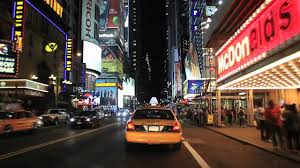The Big Apple is trying to improve, but it’s difficult for someone with mobility problems to get around its mass transit system. Only some of its subway and commuter rail stations have elevators between the street and the platform level and even if you can get into the station, and are riding to another accessible station, it’s not always possible to connect between the different train lines if you’re using a wheelchair or a scooter. Buses are more “gimp friendly.”
SUBWAYS
Getting on and off the subway car be difficult. At most stations there is a  gap, about four inches wide and two inches high, between the platform edge and the subway car; on curved platforms the space can be wider. The vertical gap on accessible subway station platforms is lower, but only near the center of the platform, near the conductor’s position. The best position for boarding should be indicated by a sign at an accessible station.
gap, about four inches wide and two inches high, between the platform edge and the subway car; on curved platforms the space can be wider. The vertical gap on accessible subway station platforms is lower, but only near the center of the platform, near the conductor’s position. The best position for boarding should be indicated by a sign at an accessible station.
If you’re using a scooter or a wheelchair on the subway you’ll need to buy a Reduced-Fare AutoGate MetroCard in order to get through the AutoGate where you pay your fare. These cards are intended for regular riders but there are also temporary cards, good for 90 days to a year.
BUSES
MTA buses have ramp/lifts and there’s priority seating behind the driver.
You can use a reduced fare farecard or pay in cash, but you’ll need to show ID to go the cash route.
COMMUTER TRAINS
Many station platforms are level with train cars but there is often a gap between the platform and the train car. If that’s the case the train’s conductor is supposed to put down a bridge plate to span that gap.
PENNSYLVANIA STATION
Penn Station, located under Madison Square Garden, serves AMTRAK plus the Long Island Railroad commuter lines.
There are two elevators from the street level to the main AMTRAK terminal. They’re not easy to find. One is on a small street that runs under Madison Square Garden, between 31st and 33rd Street. It’s on the same side of the street as the escalators that go down to the AMTRAK level. The second elevator is on 31st, near a taxi stand and just inside a freight loading area. There is an intercom/telephone near this elevator that can be used to call for “Red Cap” (porter) assistance, but the response isn’t always prompt. There are other elevators running from the main AMTRAK terminal level to the AMTRAK platforms, but you need to have a Red Cap with you to use them.
Penn Station has six elevators serving the Long Island Rail Road. One provides access from street level to the LIRR Concourse. It is located on 34th Street, just west of Seventh Avenue, diagonally across the street from Macy’s. The other elevators run from the Concourse to each of the five LIRR platforms.
Grand Central Station
Grand Central serves the Metro North Commuter line.
There are accessible entrances on Lexington Avenue at 43rd Street, at 105 E. 42nd Street east of the Park Avenue overpass and at the northeast corner of 47th Street and Madison Avenue. Elevators provide access to all levels of the Terminal.
Taxi Cabs
There are several models of cars being used as taxis in NYC. On a recent trip to New York I found that my TravelScoot scooter could fit in the trunk, or hatch, of all of them by just taking off the seat. Folding the scooter wasn’t necessary.
If you have a standard scooter or wheelchair, however, you’ll want an accessible taxi and NYC has more than 200 of them on the streets. The fare is the same as a regular cab and an  advanced reservation isn’t necessary. There are five ways to request one:
advanced reservation isn’t necessary. There are five ways to request one:
- Call 311 (The NYC government’s general information line)
- Call the Accessible Dispatch center directly:
(646) 599-9999 - Text a request:
(646) 400-0789 - Use the Accessible Dispatch mobile app
WOW Taxi (Wheels on Wheels) - Book online at:
www.accessibledispatch.com/book
IMPORTANT NOTE: This service is only available from rides going from Manhattan to anywhere else in the city’s five boroughs or LaGuardia, JFK or Newark airports. These cabs are also available at these airports for rides into the city via the regular taxi lines.
Paratransit
The NYC Transit Authority provides reserved, accessible, shared transportation called Access-A-Ride. The Americans with Disabilities Act (ADA) requires that individuals with disabilities who are unable to use accessible mass transit for some or all of their trips must be provided with this type of paratransit.
To use Access-A-Ride (AAR) service you need to apply and be certified. The fare is the same as if you used a bus or subway for your trip and needs to be paid in cash.
Can you update or add to this information to this page? Please send us your info using the form below:


